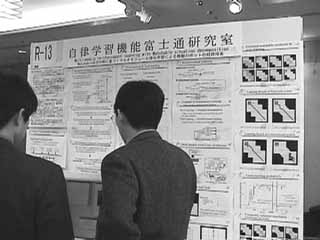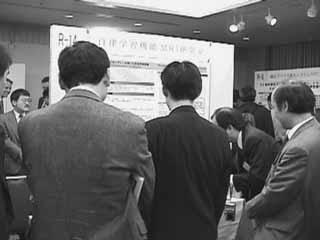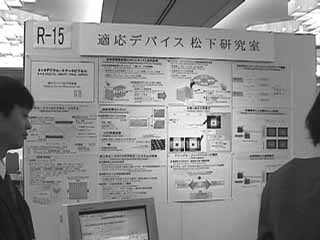Multi-module reubforcementle learning with Matchable situation
decomposition
Autonomous Learning Functions
Fujitsu
http://www.rwcp.or.jp/lab/al-fujitsu/al_fujitsu-j-seika.htm

| We propose a system design concept that decomposes environmental
situations from sensory data before learning, prepares modules that
receive only meaningful sensor data for each situation, and automatically
selects and learn the modules.
We realized the situation decomposition by estimating a criterion
"Matchability", and let each modules learn by Actor-Critic model of
reinforcement learning method.
We evaluated this concept by comparing learning performance of the
robot navigation with conventional learning algorithm.
Though, all of these sensory and action signal are inputed to the
system, only a part of them is used by the effect of situation
decomposition.
We evaluated reaching rate of the robot to goal, and compared
performance of our proposed system with conventional system in respect to
leaning time and adaptability to new environment. |
Non-speech sound recognition with microphone array
Autonomous
Learning Functions MRI
Laboratory
http://www.rwcp.or.jp/lab/activities/achievements/AL/mn/results.html

| The Autonomous Larning Functions MRI Laboratory (Mitsubishi Research
Institute,Inc.) developed a non-speech sound recognition system with sound
source direction estimater. Five types of single impulsive sounds such as
clapping of hands, impact of metalic cans and wooden boards, are
recognized at the rate of 80% in quiet office environment. A beamformer
with 16 channels microphone array estimates sound source directions at 10
degrees resolution. Thousands of non-speech sounds recorded in an unechoic
room are gathered into a RWC database that will be open for academic use.
|
8x8 Digital Smart Pixel Array
Adaptive Device Matsushita
Laboratory
http://www.rwcp.or.jp/lab/ad-matsushita/index-j.html

| We will exhibit a prototype Digital Smart Pixel Array device that
achieves high-speed optical image processing at a frame rate of less than
0.1 micro second/frame. We will also introduce experimental results by
video, etc. Each pixel of this device has an ALU and an optical
input/output section, and communicates its neighbors. SIMD type processing
is simultaneously achieved at individual pixels according to various
external instructions, and parallel data are optically transmitted to the
next digital smart pixel array via a free space optical interconnection.
This real-time processing system overcomes the parallel-serial
transformation bottleneck in conventional image processing techniques.
|


